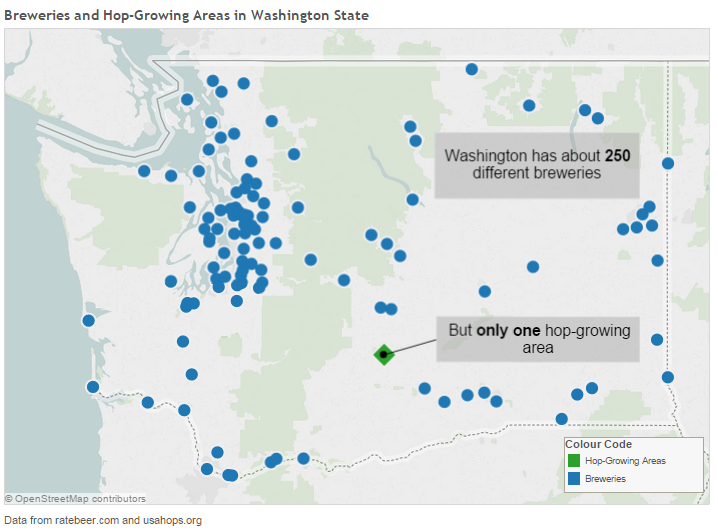Seattle is a city for making beer. There are over forty different breweries operating in the Emerald City and many of them come with bars or pubs attached – noisy, active places to hide away from the rain and sample some new label or brew.
But despite Seattle’s rain, the state is caught in a drought. And that might be bad news for anyone wanting to try their own hand at making beer any time soon.
The Drought
Now, Seattle isn’t in any danger of suddenly losing its rainy reputation, but Seattle isn’t the only place in Washington. The majority of the state lies in the much drier east, over the Cascade Mountains. Eastern Washington doesn’t share Seattle’s penchant for rain and on May 15th, Governor Jay Inslee declared a drought emergency in Washington State.
The problem is that there isn’t enough snow in the mountains. Maia Bellon, the director of Washington’s Department of Ecology, said in a release: “This drought is unlike any we’ve ever experienced. Rain amounts have been normal but snow has been scarce. And we’re watching what little snow we have quickly disappear.”

This is important because the snow acts like a battery for the state’s water supply. The mountains charge with winter snows and slowly release meltwater throughout the rest of the year. This year, however, the statewide snowpack is less than 15% of normal. The batteries are nearly empty.
Worse yet, we’re now heading into summer, which tends to be the driest part of Washington’s weather. And down south, El Niño, the quirk of warm and cold ocean currents which may help bring rain to California, is predicted to bring only more dryness and heat to Washington.
The Hops
Washington’s drought isn’t nearly as drastic as California’s, but there is a spike of severe drought conditions extending up through the map. And just inside that spike is a name that should have beer aficionados concerned – the Yakima River Valley.

The Yakima River is a tight, cold ribbon of water that runs a short ways through central Washington before turning south into the Columbia River. People go white-water rafting on it. It feeds farms throughout the region, turning Yakima into a rich agricultural farmland. And one crop in particular grows well there – hops. America is the second biggest hop grower in the world and 77% of US hops are grown in the Yakima Valley.
Hops are tight, green flower buds that brewers use to help embitter and preserve the beer. Different strains can also add different, unique flavours to the beer and, as Markus Stinson of the Elysian Brewing Company explained, “As there are more and more breweries making more and more styles, especially hop-forward beers, everyone’s looking for something new, something that’ll blow people’s minds.”
Now, the drought isn’t a catastrophe. Regional reservoirs are still high, growers can use water-rationing plants and hops are relatively drought-tolerant plants. So a sudden, drastic shortage is probably not going to happen. But there are concerns. Farmers are having to spend a lot more money buying or pumping water for their plants and the warmer winter means that the plants are sprouting earlier and producing fewer buds. And any problems this year may only be magnified if the drought continues into next year as well.
Worse, the hops market is already very volatile right now. A study from Washington State University said “the economic climate for Washington hop producers is in chaos.” Chaos isn’t something farmers tend to like and some may abandon hops altogether if they can’t be sure they’ll make their money back. “Things are currently so volatile that growers can no longer count on being able to amortize the cost of planting,” said the report.
The Beer

All this translates into some potential problems for beer makers. Large-scale buyers are usually insulated from the worst of market spikes and dips, but small, craft brewers may not be able to weather them so well. “Especially if you’re a younger company, and you’re trying to break in and you’re brewing – basically you need more hops as you’re producing more beer,” said Markus.
That could affect more people than just Seattle hipsters – more than one out of every ten beers sold in America is now a craft beer, according to a 2014 report by the Brewer’s Association.
Breweries usually sign multi-year contracts with growers to get the hops they need, said Markus. Established or regional breweries usually have the process down to a routine and have enough padding to accommodate any potential miscalculations. But smaller companies have to take more risks.
“If you’re just starting a brewery, you do want to do your hop contracting, but what you’re doing is you’re taking a pretty good leap of faith,” said Markus. For a new business, trying to guess the market in years down the line… “It’s a tricky game.” And any uptick in the price of hops can quickly eat into the bottom line.
And prices for hops have already been rising. In 2005 the average pound of hops in Washington cost $1.86 according to the Hop Growers of America. In 2014 it was more than double – $3.89 per pound. And special varieties, the kind that can blow people’s minds, can be even more, up to over $20 per pound.
There probably isn’t going to be any sort of major shortage or collapse in the beer or hops market – this isn’t that kind of situation – but if drought conditions like this continue or become more common over the years, it may cut into a lot of purses and add more instability to an already unstable market.
So if Seattleites are hoping for more new, start-up breweries to open up in the Emerald City in the next few years, they may have to wait.
